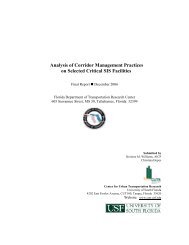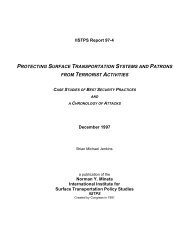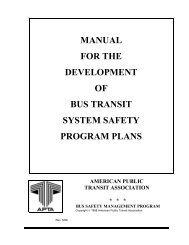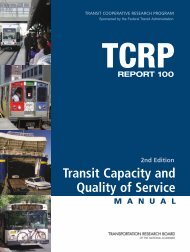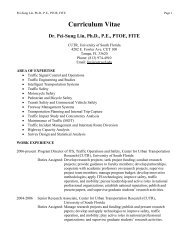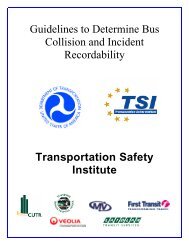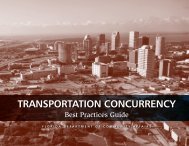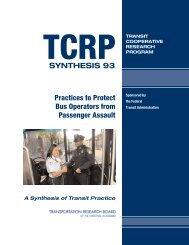a technical guide for conducting pedestrian safety assessments
a technical guide for conducting pedestrian safety assessments
a technical guide for conducting pedestrian safety assessments
You also want an ePaper? Increase the reach of your titles
YUMPU automatically turns print PDFs into web optimized ePapers that Google loves.
UNIVERSITY OF CALIFORNIA BERKELEY • INSTITUTE OF TRANSPORTATION STUDIES • TECHNOLOGY TRANSFER PROGRAM<br />
17<br />
2.3 CONVENE A KICKOFF MEETING WITH CITY STAFF<br />
On the first day of the city visit, the evaluators will meet with city staff and representatives to set the context of the<br />
Pedestrian Safety Assessment – the purpose and scope of the evaluation, Focus Area locations, and expected deliverables.<br />
At this meeting, city staff may offer, or the evaluators may request, additional in<strong>for</strong>mation. Staff may invite other<br />
city agencies and/or other individuals to participate at this meeting as appropriate.<br />
2.4 PERFORM FIELD AUDITS/ REVIEWS<br />
The evaluators will conduct field audits/ reviews at identified locations. The field review <strong>for</strong>mat and participants will be<br />
selected based on the method applicable <strong>for</strong> the geographic location and characteristics of the Focus Areas.<br />
Various alternative methods <strong>for</strong> field audits/reviews are available, and each is elaborated below. They include:<br />
➜ Walking Audit<br />
➜ Nighttime Audit<br />
➜ Economic Vitality Walking Audit<br />
➜ Target Citizen Group Walking Audit<br />
➜ Windshield Audit<br />
➜ Aerial Photograph Audit and/or GIS-based Audit<br />
➜ Proposed Development Audit<br />
➜ Existing Site Layout Audit, especially schools, retail areas, parks<br />
➜ Intercept Surveys<br />
➜ Focus Groups<br />
Where possible, every PSA will include a Walking Audit of the Focus Areas (as this is considered the most effective<br />
method to observe issues/problems and identify improvement opportunities) as well as a Windshield Audit of the larger<br />
area(s). Any of the other above-mentioned field review methods can be per<strong>for</strong>med as needed, based on the scope of the<br />
PSA, evaluators’ judgment and time availability, and the availability of participants during the two-day visit.<br />
A. Walking Audit (Walking Workshop)<br />
A Walking Audit, also known as a “walking workshop,” is appropriate <strong>for</strong> examining an intersection or cluster of intersections,<br />
a short corridor or road segment, an entire neighborhood that is to be traffic calmed, a school area, or a<br />
<strong>pedestrian</strong> zone or node. During a Walking Audit, positive practices are observed and issues and opportunity areas are<br />
noted. Observations are made on how motorists are behaving around <strong>pedestrian</strong>s, and notes are taken on <strong>pedestrian</strong><br />
behaviors, especially at intersections, or notations on where and why <strong>pedestrian</strong>s are crossing to avoid the intersection.<br />
For each opportunity area, the team discusses possible recommendations to address <strong>pedestrian</strong> <strong>safety</strong> concerns.<br />
A Walking Audit Route Map is developed in advance of the audit. The route may be selected to focus on collision “hot<br />
spots” and/or prototypical <strong>pedestrian</strong> concerns in the city (such as high-speed arterials). Stops are planned <strong>for</strong> every<br />
200 to 400 feet along the route. The walking audit is highly interactive, with many observations and “teachable



